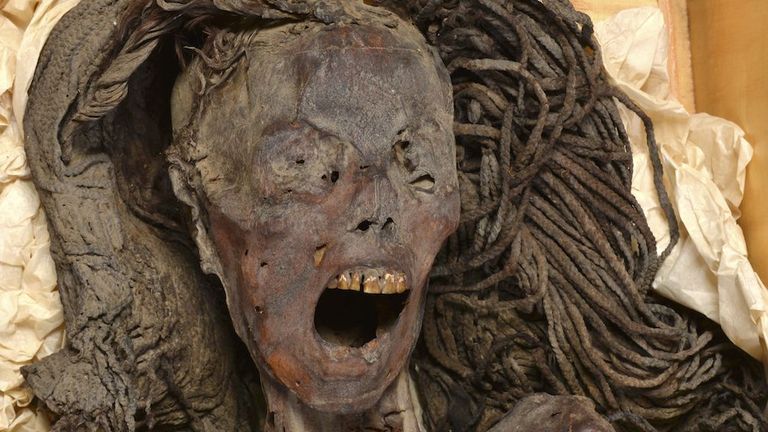A long-running conspiracy theory regarding the identity of an enigmatic youth who was touted by some as a "lost" royal prince has been debunked, a study has reported.
The latest investigation—based on a new genetic analysis—sheds light on "one of the most mysterious riddles in German history," the authors wrote in the paper.
"I love it when DNA can be brought to bear on a historical mystery," Turi King, one of the study's authors and the director of the Milner Centre for Evolution at the University of Bath in the United Kingdom, told Newsweek.
The study centers on Kaspar Hauser, a youth who appeared "seemingly out of nowhere" in the city of Nuremberg, Bavaria state, southern Germany, on May 26, 1828. Estimated to be about 16 years of age, he seemed hardly able to walk and could barely speak.
Hauser carried a letter from an anonymous writer who said that he had taken custody of the youth in 1812 and kept him in total isolation.
While he was unable to answer questions posed by the police, he was able to write the name "Kaspar Hauser" in clearly readable letters, although he seemingly did not know its meaning. Though it was clearly not his real name, the youth continued to use it.
In the following months, several distinguished individuals took care of him. His poor motor skills soon improved—although he remained relatively weak—as did his verbal proficiency. But he continued to speak in a childish way for some time. The suspicion arose that he had been entirely neglected since a young age.
According to the youth's own account, he had been kept in a small, dark dungeon without ever seeing anyone else for as long as he could remember. His sustenance consisted of only bread and water, which he was supplied by a person he never saw. At some point, a man purportedly appeared and took Hauser on a march to Nuremberg, where he left him.
The youth's story attracted criticism from many quarters, with some questioning his dungeon tale, believing that he was a fraud. Despite these criticisms, or perhaps because of them, Hauser's story—which was featured in Germany's newspapers—captured the public's curiosity, and he became something of a celebrity.
More than a year after Hauser's unexplained appearance, another dramatic event occurred: He was found lying in a pool of his own blood in the cellar of the Nuremberg house of Georg Friedrich Daumer—a teacher, poet and philosopher who was one of the people who looked after the youth in the city.
His forehead exhibited a 2-inch-long wound that appeared to have been inflicted by a sharp instrument—a murder attempt in the eyes of his supporters. His critics said the injury was self-inflicted, with Hauser's goal being to boost his declining public attention.
While the youth soon recovered, the event heralded a significant and unexpected change in his life. Ludwig I—the king of Bavaria at the time—ordered that Hauser had to be guarded around the clock by police officers.
This fueled speculation that Hauser was not simply a neglected youth but a person of political relevance, possibly of noble origin. A conspiracy theory arose suggesting that he was an abducted prince of the Grand Duchy of Baden, a former sovereign state located in what is now southwest Germany. This popular explanation is known as the "prince theory."
"The identity and origin of Kaspar Hauser have been the subject of research and controversial debate for nearly 200 years. Besides the opinion that he was merely a pathological liar and deceiver, the most enduring theory is that he was the hereditary prince of Baden who was born on September 29, 1812, and who died (officially) at the age of just 18 days—even before he was given a name," said Walther Parson, the study's lead author, who is with the Institute of Legal Medicine, Medical University of Innsbruck, in Austria.
According to this theory, the prince could be the son of the Grand Duke Carl of Baden. The theory goes that Hauser was kidnapped and swapped as a newborn in his father's castle by a countess who replaced the child with the fatally ill son of one of her employees. Her goal was to pave the way to the throne for a different royal lineage.
The substituted baby soon died and was buried as the prince, while the real prince lived on in secrecy, later becoming Kasper Hauser, the theory says.
In the past 28 years, various genetic analyses have been carried out to clarify Kaspar Hauser's origin. But these have yielded contradictory results.
In the latest study, which has been accepted for publication in the journal iScience, Parson and his colleagues present the results of new DNA analyses of hair samples assigned to Hauser that they say resolves the controversy of his potential royal origin.
The team analyzed traces of mitochondrial DNA, which is passed down the mother's line. This mtDNA clearly deviated from the Baden lineage, the study found. So the results rule out a maternal relationship to the House of Baden and, subsequently, the widespread "prince theory," Parson said.
Nevertheless, the true identity of Hauser—who died only five and a half years after his mysterious appearance by an assassination (as his supporters say) or a self-inflicted injury (as his critics say)—remains a mystery.
"We now know that Kaspar Hauser was not the prince of Baden. But we don't know (yet) who he really was," Parson told Newsweek. "However, we emphasize that this result should not be misunderstood as evidence for the competing 'fraud theory' because even if Kaspar Hauser was not a prince, he could nonetheless have been a crime victim."
Do you have a tip on a science story that Newsweek should be covering? Do you have a question about archaeology? Let us know via science@newsweek.com.
Disclaimer: The copyright of this article belongs to the original author. Reposting this article is solely for the purpose of information dissemination and does not constitute any investment advice. If there is any infringement, please contact us immediately. We will make corrections or deletions as necessary. Thank you.



